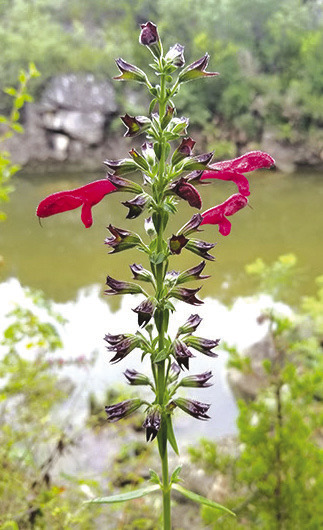Perennial plant occurs along streams and ravines in central Texas
The U.S. Fish and Wildlife Service is proposing to list the big red sage, a plant species endemic to the Edwards Plateau of central Texas, as endangered under the Endangered Species Act. The Service is not proposing to designate critical habitat for this species, as providing precise plant locations could increase the threat of illegal collection. A 60-day public comment period on the proposed listing will close on March 24.
First described in the 1840s, big red sage was presumed extinct until it was rediscovered in 1980. Since rediscovery, the total population of big red sage has declined. Of the 14 populations known to contribute to the viability of big red sage, only seven confirmed existing populations remain.
“Although big red sage is commonly planted in cultivated landscapes, this showy plant is rarely spotted in the wild,” said Amy Lueders, the Service’s Southwest Regional Director. “It is currently on the verge of extinction, and our goal is for big red sage to remain a part of the living natural heritage of Texas and the nation.”
Big red sage occurs on bluffs and banks along waterways on mostly privately owned land in the Edwards Plateau of central Texas. When flowering, the aptly named big red sage has impressive five-foot-tall stalks covered with reddish-purple flowers. It blooms opportunistically from May through November, if there is sufficient moisture seeping through the fractured limestone.
“Conserving this stunning, rare flowering plant cannot be achieved alone,” Lueders said. “We are grateful for the conservation efforts of the Botanical Research Institute of Texas, Cibolo Center for Conservation, Lady Bird Johnson Wildflower Center, and Texas Park and Wildlife Department. We also need help from private landowners, businesses, state partners and non-profit organizations in preserving not only big red sage, but also its genetic diversity.”
Because of its beauty and ability to easily germinate, big red sage is highly sought for cultivation. Research shows that wild populations of big red sage have very low genetic diversity, yet still have four times more unique genotypes than cultivated populations. Genetic diversity provides increased adaptive capability to respond to changing environments.
The perennial big red sage can reproduce vegetatively from rhizome-like stems, living upwards of 10 years. Hummingbirds frequently visit flowering big red sage seeking nectar, and simultaneously provide gene flow between plant populations. A unique structure within its tubular flowers allows effective pollination by hummingbirds while excluding other pollinators.

Threats to big red sage include consumption from browsing animals including white-tailed deer; urban development and other forms of habitat conversion; collection and inappropriate propagation (i.e., breeding in captivity using closely related wildsourced individuals that results in inbreeding and decreased genetic diversity); and flash floods, bank erosion, and moisture loss due to climate change.
The Service is committed to transparency in decision-making and encourages the public, federal and state agencies, Tribes, and other stakeholders to review the proposed rule and accompanying supporting materials during the 60-day public comment period, available at the Federal Register on Jan. 21, 2025 under docket number FWS-R2-ES-2024-0083.
Across the Southwest, the Service makes new partnerships and augments existing partnerships to bolster conservation for at-risk species. Many fish, wildlife and plant species have avoided Endangered Species Act listing thanks to the collaborative efforts of federal agencies, states, Tribes and private landowners, with the ESA serving as a catalyst for conservation efforts that help protect at-risk species and their habitat. Learn more about the Endangered Species Program and how you can help at-risk species.
The U.S. Fish and Wildlife Service works with others to conserve, protect, and enhance fish, wildlife, plants, and their habitats for the continuing benefit of the American people. For more information, visit www.fws.gov, and connect with us on social media: Facebook, Instagram, X (formerly known as Twitter), LinkedIn, Flickr, and YouTube.








